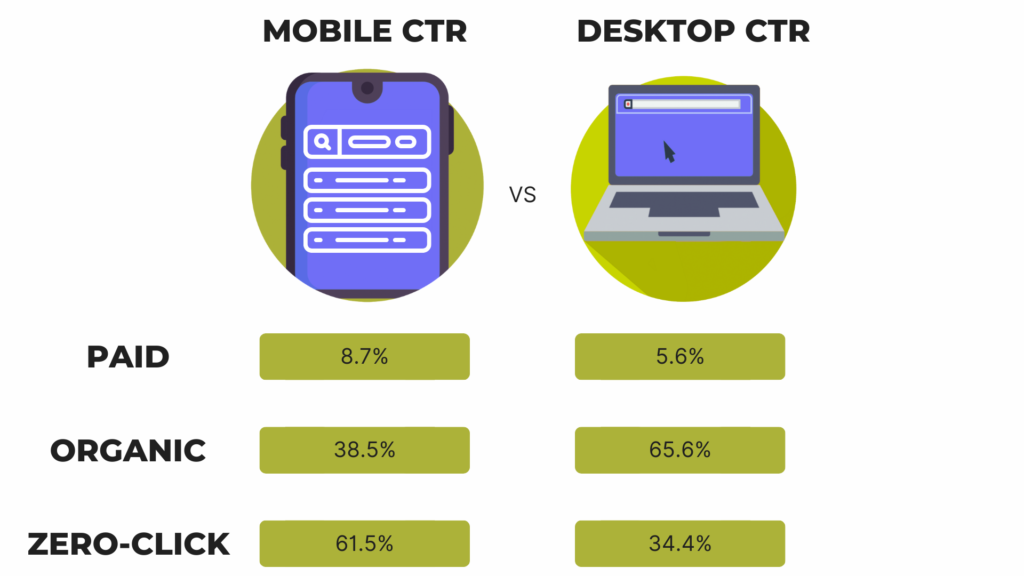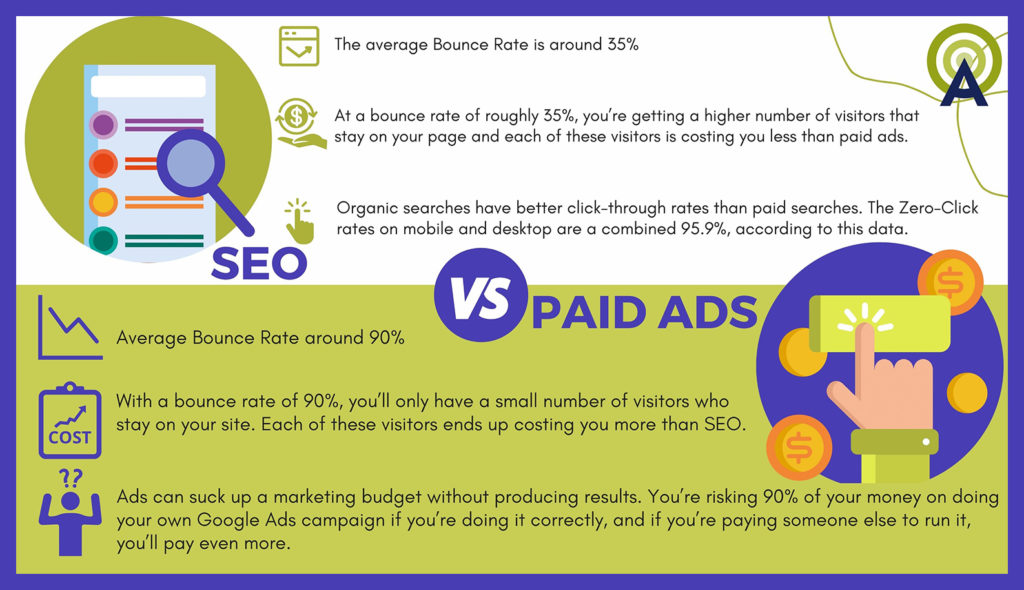
The quick answer is yes! A high bounce rate (and some other cons we’ll cover) means you’re most likely throwing your money away on Google Ads. Clients often ask us whether Google Ads are necessary and if SEO is enough. SEO is worth the cost, but Google Ads don’t have a good ROI (return on investment). In this post, we’ll explain how you can save money and increase rankings if you skip Google Ads and focus on SEO to increase traffic and conversions. Plus, you can get a free SEO analysis to start improving your SEO now to grow your company in 2021.

SEO
- Average Bounce Rate around 35% (qualified visitors)
- A trusted SEO company will manage your SEO campaign at a constant cost.
- White Label SEO Marketing can help mitigate costs while you focus on your day-to-day business
- Let’s say you’re getting 500 organic impressions at a $500 monthly campaign spend, and getting 200 qualified clicks from those impressions (figuring you’re in the top 3 spots on page 1). At a bounce rate of roughly 35% you’re getting 130 qualified visitors that stay on your page and each of these visitors is costing you less than $4.
- Organic searches have better click-through rates than paid searches. Check out the image below (data from jump shot and screenshot from Moz). Zero-Click refers to the percentage of people who search but don’t click on any of the search results. The Zero-Click rates on mobile and desktop are a combined 95.9%, according to this data.
Google Ads
- Average Bounce Rate around 90% (unqualified) (meaning 9 out of 10 people leave your site after only visiting one page)
- Say you spend $500 at $2.50 per click on an Ads campaign. With a bounce rate of 90%, you’ll only get 20 qualified visitors who stay on your site. Each of these visitors end up costing you $25.
- Google Ad campaigns appear more DIY, which can often make it seem like you are in control, but it’s difficult to set up and run a successful ad campaign. Plus, it can suck up a marketing budget without producing results. You’re risking 90% of your money on doing your own Google Ads campaign if you’re doing it correctly, and if you’re paying someone else to run it, you’ll pay even more.
Now that you’ve compared SEO and Google Ads, we’ll cover the basics of Google Ads and SEO, and get into more of the cons.
What are Google Ads?
Google Ads (formerly Adwords) is a pay-per-click (PPC) advertising tool that businesses use to promote themselves on Google searches, YouTube and other sites across the web. Search ads are a popular form of paid advertising because many people use Internet search engines like Google. PPC places ads in search results or on web pages to generate traffic to your website. The ads are typically tied to keywords or placed on sites with similar content to your ad. Instead of paying for the ad, you pay if someone clicks on this ad to head to your website.
Google Ads Drawbacks
Google Ads aren’t for everyone. Here are some cons to Google Ads:
- Cost—Ads cost money and can get expensive if you’re in a competitive industry. You might not have a large marketing budget for Google Ads. On the other hand, SEO can send you customers without costing a fortune. SEO increases visibility and the cost is the same whether you reach 5 or 5,000 customers.
- Effectiveness—If you’re running a campaign for an extended period of time, you’ll need to mix up the look and content of your ads so that viewers don’t get saturated with your business.
- High bounce rates—If someone reaches your site by mistake by clicking on your ad, then your bounce rate will be high. Google Ads have a bounce rate of about 90%. High bounce rates negatively impact your site (site’s SEO by telling Google your content is low-quality in relation to the keyword). You want visitors to spend time on your site and consume your credible content.
- Short shelf life—When your budget runs out of money, your ads stop. This means any leads could also drop.
- Ad limits—The look of your ad is restricted by the number of characters in the headline and descriptions. You’ll also want to include keywords, call to action and an attention-grabbing headline. There’s an art to Google Ads and you won’t want to waste your money if you’re writing poor ad copy.
- Learning curve with Google Ads—You’ll need to research how to effectively set up campaigns so they work properly. Once everything is set up, you’ll need to consistently monitor the campaign to make sure it’s running smoothly and getting you conversions. If it doesn’t, you’ll need to know how to tweak your campaign. All of these actions require your time (and an educational curve).
Examine Your SEO
Google Ads don’t make sense for every business, but SEO does! SEO optimization is a form of online marketing where you use effective keywords to help potential customers find your business through web searches. Check out our blog if you want detailed SEO content. Effective SEO gets your business to appear on Google page 1 so you get more visibility.
Here are some common and effective SEO tactics:
- Keyword analysis and research: It’s important to zero in on effective keyworks through research and then make those keywords work for you. You’ll see a boost in rankings by including short tail and long-tail keywords in headings, link anchor texts (link title) and page titles. We have plenty of details on how to do this (Finding the Right Keywords, Using Your Keywords and Keyword Selection is Key).
- Rewriting meta tags to be more relevant: Update meta tags to make sense for readers and make sure they’re each unique. It’s important to include keywords in your meta tags, but not overstuff them (don’t pack your content with so many keywords that your content is unreadable) (maybe link here to blackhat blog).
- Internal linking: Link to other relevant pages on your website. For example, if you’re writing a blog post about types of carpet, you can link to your site’s carpet selection page. It’s a relevant link that helps your reader see what carpet selections you offer.
- Link building: This involves the number of external sites that link to your site. For example, let’s say a tile manufacturer is mentioned in a blog you published on tile trends. As a result, they link to your blog on their site. These links can also be social media posts that link to your site (Facebook, Twitter, Instagram, LinkedIn, Pinterest, etc.).
- Adding helpful content: Aim to have site content that satisfies what people are searching for during organic Google searches. Break up the text in your page with headings so readers can find what they want. Write for your audience’s level of expertise and try not to sound “spammy.” Readers will be able to tell if you’re repeating keywords for Google’s sake rather than providing credible content. You want content to sound natural, even with some keywords woven into your pages.
Hopefully, this post gave you a better understanding about Google Ads and the importance of SEO. Contact us if you want some SEO guidance or want more information about Google Ads. Contact us for a free SEO analysis to see what improvements need made to grow your business and increase rankings. We’re happy to help answer questions and increase your traffic!


